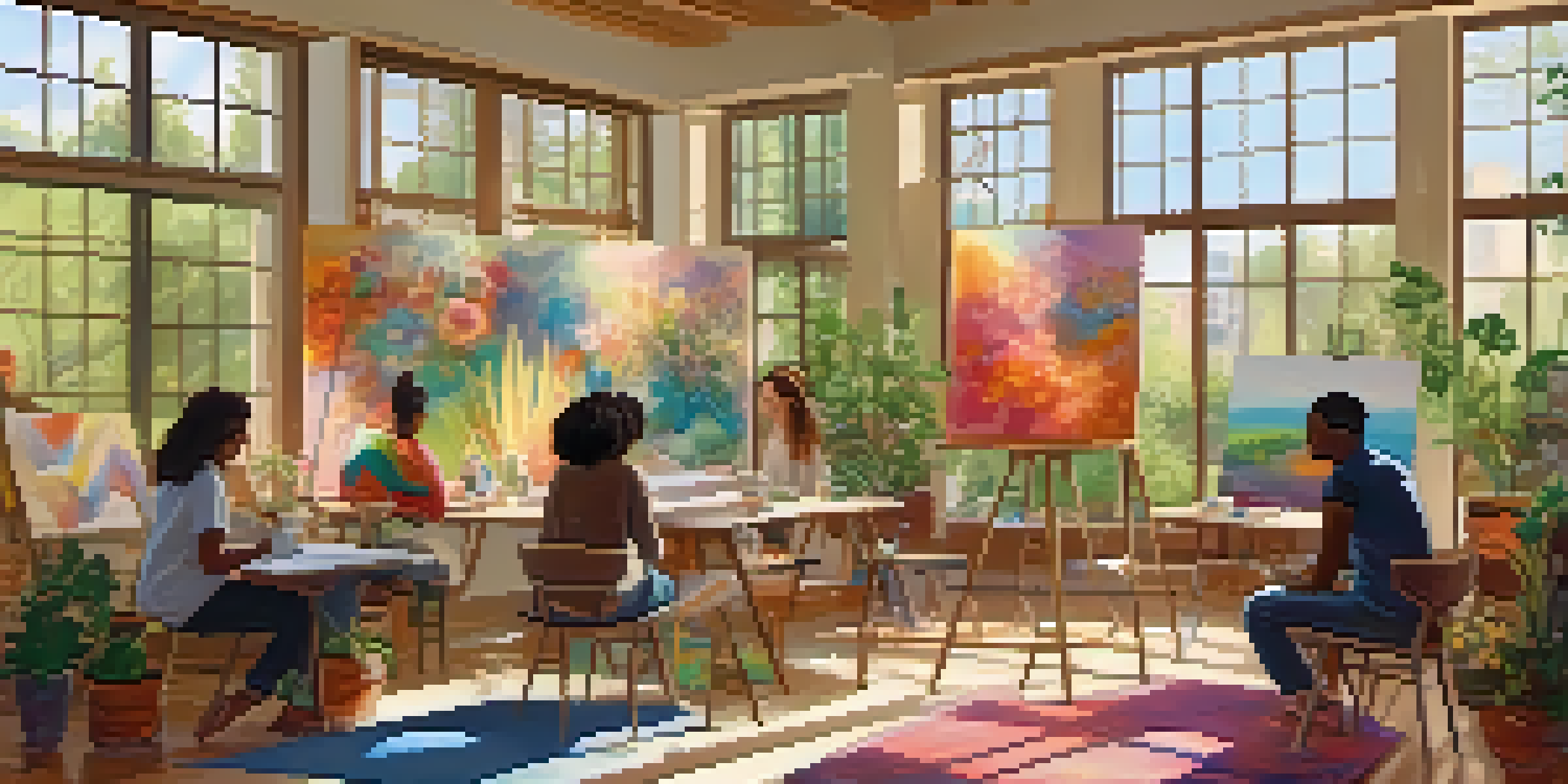The Role of Art Therapy in Mental Health Crisis Management

Understanding Art Therapy and Its Importance
Art therapy combines the creative process of making art with psychotherapy. This approach allows individuals to express feelings that may be difficult to articulate with words. By engaging in artistic activities, clients can explore their emotions and experiences in a safe environment.
Art is the most beautiful of all lies.
The practice is rooted in the belief that creative expression can lead to healing and personal growth. It is especially effective in mental health crisis situations, where traditional talk therapy might not be as accessible. Through art, clients often find a pathway to self-discovery and relief.
For many, creating art can be a therapeutic outlet that promotes mindfulness and reduces anxiety. This unique form of therapy serves as a bridge between the inner emotional world and the external reality, making it an invaluable tool in mental health management.
How Art Therapy Supports Crisis Management
During a mental health crisis, individuals may feel overwhelmed and disconnected from themselves. Art therapy provides an alternative means of communication, allowing clients to express their pain through creativity. This can lead to immediate emotional relief and improved coping strategies.

Art therapy sessions can help clients process traumatic experiences and emotions that may contribute to their crisis. By focusing on the creation of art, individuals can distance themselves from their distressing thoughts. This shift in focus can be incredibly empowering and can facilitate healing.
Art Therapy Facilitates Emotional Expression
Art therapy provides a unique outlet for individuals to express complex emotions that might be difficult to articulate verbally.
Moreover, art therapy fosters a sense of control and agency. As clients create, they make choices about colors, materials, and forms, which can translate into a greater sense of empowerment in their lives outside of therapy.
The Therapeutic Process of Art Creation
The process of creating art in therapy can be profoundly therapeutic. It encourages individuals to engage with their feelings and thoughts in a non-threatening way. For example, a person might paint their feelings of sadness without having to discuss them verbally.
Every artist dips his brush in his own soul, and paints his own nature into his pictures.
Art materials can also have a calming effect, allowing clients to focus on the texture, colors, and forms rather than their anxiety. This sensory engagement can ground individuals during times of emotional turbulence, making it easier to navigate their crisis. It's a form of mindfulness that emphasizes presence in the moment.
Additionally, the act of creating something tangible can instill a sense of accomplishment and pride. This is especially crucial during a mental health crisis when feelings of worthlessness or hopelessness often prevail.
Art Therapy Techniques for Crisis Situations
Various art therapy techniques can be utilized during mental health crises, tailored to individual needs. Techniques such as drawing, painting, or sculpting can serve as outlets for expression. Each medium offers different ways to communicate feelings and thoughts, making therapy flexible and dynamic.
For instance, a therapist might encourage a client to create a collage representing their emotions. This can help visualize complex feelings and spark discussions about them. Similarly, using clay can provide a tactile experience that grounds individuals, allowing them to release pent-up tension.
Empowerment Through Creative Control
Clients gain a sense of control and agency by making choices in their artistic creations, which can enhance their overall empowerment.
These techniques not only facilitate emotional expression but also promote problem-solving and critical thinking skills. By engaging in the creative process, individuals may discover new perspectives on their challenges, empowering them to take proactive steps toward recovery.
The Role of the Art Therapist in Crisis Management
The art therapist plays a crucial role in guiding individuals through their healing journey. They create a safe and supportive environment where clients feel free to express themselves without judgment. This therapeutic relationship is essential for building trust and facilitating open communication.
Art therapists are trained to recognize the emotional and psychological needs of their clients. They use their expertise to adapt art activities to align with the client's emotional state and crisis situation. This personalized approach ensures that therapy is effective and responsive.
Moreover, art therapists often collaborate with other mental health professionals to provide comprehensive support. By integrating art therapy within a broader treatment plan, they can contribute to a holistic approach to crisis management.
Benefits of Art Therapy in Mental Health Crises
Art therapy offers numerous benefits for individuals facing mental health crises. One of the most significant advantages is the ability to process emotions without relying solely on verbal communication. This can be particularly helpful for those who struggle to articulate their feelings.
Additionally, engaging in art can lead to improved emotional regulation. As individuals create art, they learn to identify and manage their emotions better, reducing feelings of overwhelm. This skill is vital in crisis situations where emotional responses can escalate quickly.
Effective Tool for Crisis Management
Art therapy serves as a valuable resource during mental health crises, offering immediate emotional relief and improved coping strategies.
Furthermore, art therapy can foster resilience and coping skills. Clients often leave sessions with a greater understanding of their emotions and newfound strategies for managing stress, which can be essential in navigating future challenges.
The Future of Art Therapy in Mental Health Care
As awareness of mental health issues grows, so does the recognition of art therapy as a valuable tool. The integration of art therapy into mental health care practices is becoming more common, offering new avenues for healing. More practitioners are training in this specialized field, expanding access to art therapy.
Research continues to support the effectiveness of art therapy in crisis management, encouraging healthcare providers to incorporate it into treatment plans. As we learn more about the brain's response to creativity, the potential for art therapy to aid in mental health recovery becomes increasingly evident.

Looking ahead, art therapy may play a pivotal role in preventive mental health strategies. By promoting creative expression in schools and communities, we can foster emotional resilience and equip individuals with coping skills before crises arise.